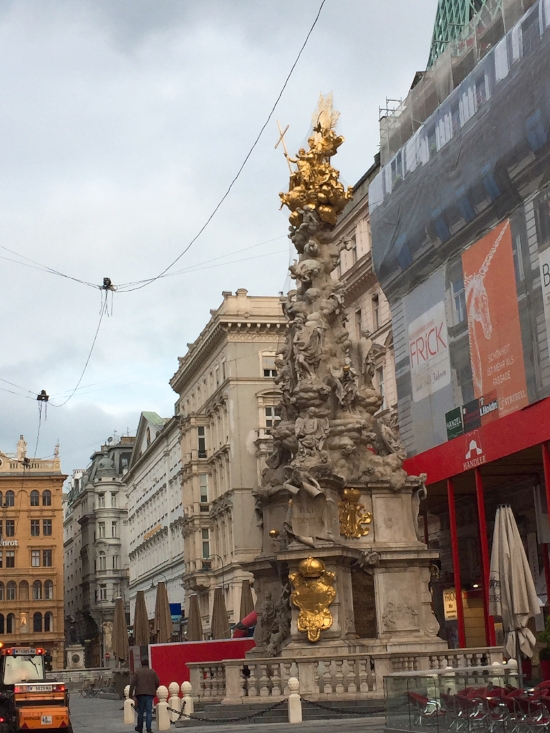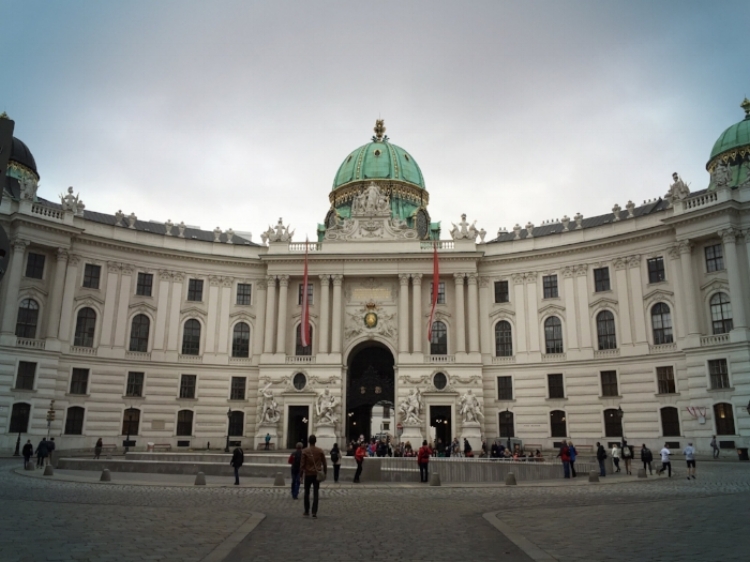Vienna Highlights: Part 1
St. Stephen's Cathedral at the heart of Vienna.
New York, Paris, London -- they each have their own individual charm and majesty, to say the least. Call me biased, and rightfully so, but I've always been quite attached to Vienna. Maybe its because I've spent my childhood years there, wide-eyed wandering around this city and getting to learn its many facets. Or perhaps it's how the Viennese have a strong affinity for their cultural pride and heritage. It can also be how the city has showcased its grandeur as the capital of the Austro-Hungarian Empire. I really can't pinpoint why this city has made such an impression on me ... maybe its all these reasons rolled into one.
I know I wouldn't do justice to Austria's capital by a single blog and so I've decided to make this a two-part post. There are just too many things to see and do in Vienna, so I've zeroed-in on specific areas within the Central 1st District or as the Viennese call it, the Innere Stadt, bounded by the Ringstaße Boulevard as well as my personal favorites. I believe that as far Vienna is concerned, the vibrant artistry of this city is concentrated within the area of the central district, the capital of the Imperial Hapsburg Empire with St. Stephen's Cathedral at its core. Try as I may, I may never adequately express the beauty and splendor of this city since I am evidently ill-equipped to do so. What I wish to do instead, is to share the places and experiences that have made me fall in love with Vienna in hopes that others such as yourself, may want to experience it for themselves and create your own memories.
St. Stephen's Cathedral (Stephansdom)
St. Stephen's Cathedral is, more often than not, the initial (or sometimes final) stop made by tourists who venture into Vienna by foot. This area is bursting with people almost all the time, both by lokals and tourists alike. I knew that had to make this my first stop during my first visit after nearly three decades. St. Stephen's Cathedral is a place that holds a special place in my heart. Its Gothic designs are reminiscent of a time gone by where people would flock to this area every Sunday to attend mass – and they still do! Alex and I arrived on a Sunday, and we were able to hear mass in St. Stephen's along with a good number of Viennese residents. I have such an attachment to this place and chose our very own Basilica De San Sebastian as my preferred venue to have our wedding. San Sebastian, the only steel church in the Philippines also boasts of the same Gothic design that of St. Stephen's Cathedral.
The roof of St. Stephen's Cathedral is composed of colorful tiles that were donated by the Viennese after it's destruction during the Second World War and pride themselves for owning a piece or two of their country's history. Photo by LordRunar/iStock / Getty Images
Graben is located within St. Stephen's Square and is a pedestrian street dedicated to shopping and dining. This walkway has long been known as a shopping area by the Habsburgs due to its close proximity to the Hofburg Palace. Back in the day, goods being consumed by the members of the Imperial Palace would come straight from these stores. Today, more modern and international brand names such as H and M, Lacoste, are placed side by side with Parfumerie J. B. Filtz, Vienna's long-standing perfume makers of the Austro-Hungarian monarchy as well as the more traditional Austrian brand, Julius Meinl with their gourmet coffee and other deluxe merchandise.
St. Stephen's Square.
Within the street of Graben is a column dedicated to the plague that is made from pure marble.
This famous coffee house is an institution and was the hangout place for prominent individuals such as Sigmund Freud, Leon Trotsky and Alfred Polgar. Here, they would sip some coffee and have heady discussions about the goings on in Viennese society. Café Central is located inside the Palais Ferstel. The Palais Ferstel is a tribute to Italian design that was created by its architect, Heinrich von Ferstel. He was inspired to incorporate a little bit of Venice in Vienna after coming home from a trip to Italy thus resulted in the building's elaborate Italian Renaissance style.
Along the passageway of the Palais are restaurants and other specialty shops for you to linger in.
Jesuit Church (Jesuitenkirche)
The Jesuit Church is also known as the Universitätkirche. It boasts of having one of the most elaborate Baroque interiors in Europe. This university church is dedicated to the Jesuit saints Ignatius of Loyola and Franciscus Xaverius. Noted for its high-baroque decorations, galleries, columns, and the trompe l'oeil painting on the ceiling giving the illusion of a dome, these where later additions to the church by Andrea Pozzo.
Alex personally requested to visit this church as an homage to the Ateneo de Manila University.
Baroque interiors of the Jesuit Church.
Trompe l'oeil ceiling of the church.
Burgtor Gate at Heldenplatz (Äußere Burgtor)
Within the Hofburg, is the full triumphal arch, known as the Äußere Burgtor or Heldentor. Originally built into the city's defensive walls, the arc pays tribute to the Battle of Leipzig where Austria along with its allies defeated Napoleon's troops.
This arc structure was designed by Peter von Nobile and was erected through the years 1821 until 1824.
The Hofburg Palace is the soul of Vienna's Old Town. This structure houses Vienna's most beautiful cultural and historical establishments such the apartments of Imperial apartments of Empress Elisabeth also known as "Sisi", the Spanish Riding school, performance venue of the Vienna Boys Choir called the Hofburgkapelle, the office of the Austrian President, Austrian National Library and the Church of the Augustinian Friars all within a stone's throw away from St. Stephen's Cathedral.
The seat of power of the Imperial Vienna lies behind these walls.
Spanish Riding School (Spanische Reitschule)
As a child, I always admired these white Lipizzaner horses of the imperial palace. I would stare in awe at these magnificent, graceful creatures that galloped their way across the Spanish Riding School in Vienna. This is the perfect exhibition of man and beast in complete harmony with one another. The riders and horses' are known for the dressage, which is the art of riding or training of a horse to develop obedience and skill. The Lipizzaner horses are best known for the Haute école, which are movements, used in classic riding competitions that are natural for horses. These movements include the piaffe and levade, courbette and the capriole. These horses exhibit equine ballet at its very best.
Imperial Court Chapel in Hofburg (Hofburgkapelle)
At the oldest part of the Palace lies the Hofburgkapelle. Here, Sunday mass at this place is made extra special when you are an audience to the Vienna Boy's Choir or Die Wiener Sängerknaben accompanied by the top musicians. Hearing the angelic voices of these young men accompanied by the inspirational words of the faith is indeed a once in a lifetime experience.
Austrian National Library (Österreichische Nationalbibliothek)
The Austrian National Library houses not only priceless collections of books but also showcases several museums. This place is massive with its Baroque architecture and overall feel of the library that I love. I can revel in this place for hours at a time -- just like Belle in Beauty and the Beast.
The Austrian National Library is known to be the most extensive library in the country.
Church of the Augustinian Friars (Augustinerkirche)
This famous court church of St. Agustin is where a number of notable weddings took place such as Empress Maria Theresia who married Franz Stefan von Lothringen in 1736, Emperor Franz Joseph I married Elisabeth or "Sisi" in 1854, Crown Prince Rudolf married Princess Stephanie in 1881 and even the French Emperor Napoleon married the Austrian Princess Marie Louise here in 1810. Known as the family church of the Habsburg Dynasty, it stores 54 hearts of its representatives within silver urns of the Crypt of Hearts known as the Herzgruft.
Today, masses are still held at the Augustinerkirche accompanied by the music of Mozart, Hadyn, and Schubert.
People's Garden (Volksgarten)
The Volksgarten or The People's Garden is the first park in Vienna that was created for the public. Situated beside the Heldenplatz and the Hofburg building, this park is a great way to sit on the bench and soak in the beauty of the blossoming rose garden and listen to the trickling fountain waters nearby.
If you're looking for a good hotel at the center of Vienna, that's close to St. Stephen's Cathedral, then Hotel Lamée is the place to be. Conveniently situated inside the Innere Stadt or the Central 1st District, it's literally a stone's throw away from the capital of Imperial Vienna. Hotel Lamée also boasts of having the best rooftop bars in the city – just an added feature to this pleasant hotel.
Alex and I at the rooftop with St. Stephen's Cathedral in the background.
That's it for part 1. I end this post with a video that gives an overall look of Vienna.
Watch out for more in part 2 ...















